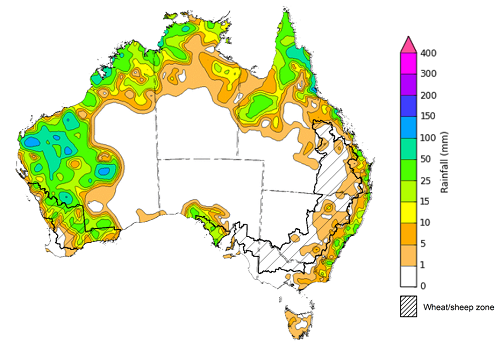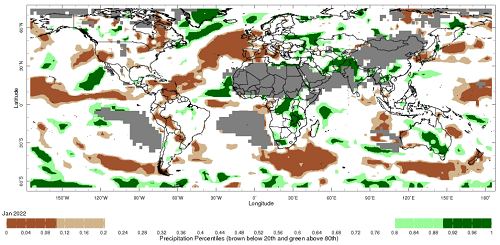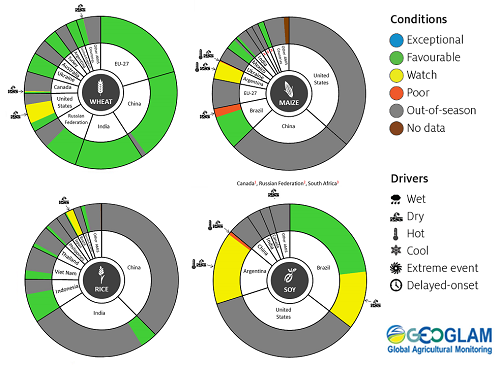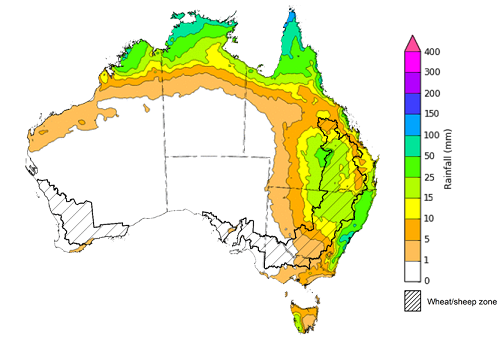Key issues
- For the week ending 16 February 2022, a series of low-pressure troughs resulted in rainfall across western, northern and coastal areas of eastern Australia. High-pressure systems to the south of Australia brought clear, dry conditions to large areas of central, eastern and southern Australia.
- Dry conditions across southern Queensland and northern New South Wales have likely allowed harvesting of early sown summer crops to resume, after rainfall last week stalled activity. Sowing of late sown summer crops in Central Queensland has likely continued over the past week. However, upper soil moisture levels are currently average to below average, and further rainfall will be needed to support germination and establishment.
- Global crop production conditions have been generally favourable for the major grain and oilseed producing countries despite dry conditions across parts of Argentina, Brazil, and the United States, affecting the production potential of wheat, corn and soybeans.
- Below average rainfall during January is likely to result in lower-than-expected winter wheat production in the United States and decreased corn and soybean production across parts of Argentina and Brazil. Average to above average rainfall across the Black Sea Region and part of Europe is likely to improve production prospects in these key production regions. This is providing, on balance, similar global production conditions to those seen back in November 2021, that were used to formulate ABARES forecasts of global grain supplies and the impact on world prices in its December 2021 edition of Agricultural commodities.
- The global climate outlook indicates that average to above average rainfall is slightly more likely between March and May 2022 for most of the world's major grain- and oilseed-producing regions. Partly due to the influence of La Niña, below average rainfall is expected for Argentina, southern Brazil, parts of western Europe, west Asia, and southern and western United States.
- Over the 8-days to 24 February 2022, rainfall is expected across northern and eastern parts of Australia. Onshore winds and tropical moisture are expected to bring showers and storms to northern Australia, while low-pressure troughs are forecast to bring showers to eastern parts of the country. Meanwhile, high pressure systems are expected to bring mostly dry conditions to much of western, central and southern Australia.
- Water storage in the Murray–Darling Basin (MDB) decreased by 55 gigalitres (GL) between 9 February 2022 and 16 February 2022. The current volume of water held in storage is 22,237 GL, which represents 88 of total capacity. This is 61% or 8,425 GL more than at the same time last year.
- Allocation prices in the Victorian Murray below the Barmah Choke decreased from $85 per ML on 28 January 2022 to $75 per ML on 4 February 2022. Prices are lower in the Goulburn-Broken, Murrumbidgee, and regions above the Barmah Choke due to the binding of the Goulburn intervalley trade limit, Murrumbidgee export limit, and Barmah Choke trade constraint.
Climate
For the week ending 16 February 2022, a series of low-pressure troughs resulted in rainfall across western, northern and coastal areas of eastern Australia. High-pressure systems to the south of Australia brought clear, dry conditions to large areas of central, eastern and southern Australia.
Rainfall totals of between 10 and 50 millimetres were recorded across parts of eastern New South Wales, eastern and northern Queensland, southern parts of South Australia, western and northern parts of Western Australia and the north of the Northern Territory. Rainfall totals in excess of 50 millimetres were recorded in parts of northern Queensland, the west and north of Western Australia and isolated parts in the north of the Northern Territory. Remaining parts of Australia received little to no rainfall.
In cropping regions, rainfall totals of between 10 and 50 millimetres were recorded across western parts of South Australia and much of Western Australia. Little to no rainfall was recorded across cropping regions in New South Wales, Queensland and Victoria, as well as eastern parts of South Australia.
Dry conditions across southern Queensland and northern New South Wales have likely allowed harvesting of early sown summer crops to resume, after rainfall last week stalled activity. Given the ample soil moisture availability at the start of the summer cropping season and the largely dry finish for early sown crops, above average yields and good grain quality are expected. Sowing of late sown summer crops in Central Queensland has likely continued over the past week. However, upper soil moisture levels are currently average to below average, and further rainfall will be needed to support germination and establishment.
Rainfall for the week ending 16 February 2022
Note: The rainfall analyses and associated maps utilise data contained in the Bureau of Meteorology climate database, the Australian Data Archive for Meteorology (ADAM). The analyses are initially produced automatically from real-time data with limited quality control. They are intended to provide a general overview of rainfall across Australia as quickly as possible after the observations are received. For further information go to http://www.bom.gov.au/climate/rainfall/
Crop production is affected by long-term trends in average rainfall and temperature, interannual climate variability, shocks during specific growth stages, and extreme weather events (IPCC 2012). Some crops are more tolerant than others to certain types of stresses, and at each growth stage, different types of stresses affect each crop species in different ways.
The precipitation anomalies and outlooks presented here give an indication of the current and future state of production conditions for the major grain and oilseed producing countries which are responsible for over 80% of global production. This is an important input to assessing the global grain supply outlook.
January precipitation percentiles and current production conditions
As of the end of January 2022, rainfall was mixed for the world’s major grain-producing and oilseed-producing regions.
In the northern hemisphere, precipitation was below average in the central southern and western United States, southern Kazakhstan, western Europe, the United Kingdom and parts of eastern Canada. Precipitation was above average for Southern Russia and Volga districts of the Russian Federation, central Canada, central China, northern Ukraine. Precipitation was close to average across the remainder of the major grain-producing and oilseed-producing regions in the northern hemisphere.
In the southern hemisphere, January precipitation was below average in northern Argentina, Paraguay, Uruguay and western Australia. Precipitation was above average across parts of northern Brazil and South Africa. Precipitation was close to average across the remainder of major grain-producing and oilseed-producing regions in the southern hemisphere.
Global precipitation percentiles, January 2022
As at 28 January 2022 global production conditions were generally favourable for the production of rice and wheat. However, a lack of precipitation has affected the production potential of corn and soybeans in some key grain exporting and importing countries.
In the northern hemisphere production conditions for wheat have been generally favourable. Climatic conditions have been favourable for wheat development in Canada, China, the European Union, the Russian Federation, Turkey, Ukraine and the United Kingdom. Production is mixed in the United States due to dryness in some areas. Conditions were favourable for winter wheat sowing in India.
Conditions for corn in Argentina for early- and late-planted crop development are rated at below average due to drought and high temperatures affecting yield potential. Similarly in Brazil, conditions were mixed for spring-planted crop development due to dryness in the south. Conditions were favourable in Brazil for sowing the summer-planted crop. In India, conditions were favourable for Rabi crop development. In South Africa, conditions are favourable for crop development.
Conditions were favourable for transplanting of Rabi rice in India. Harvesting conditions were favourable for dry-season rice in Indonesia and sowing of wet-season rice. In the Philippines, Thailand and Vietnam conditions were favourable for the harvest of wet-season and sowing of dry-season rice. In Brazil, conditions are under watch due to low irrigated water availability.
Conditions for soybeans were mixed in Argentina. The early-planted crop is under below average to poor conditions because of a prolonged drought and high temperatures. Sowing of the late-planted crop is wrapping up under slightly better conditions as the drought conditions occurred during the early vegetative stages and recent rainfall has been beneficial. In Brazil, most crops are in the reproductive stages, with harvest just beginning in some places. In northern and central regions, crops are under favourable conditions. However, in the southern region reduced yields are expected due to dryness.
Crop conditions, AMIS countries, 28 January 2022
Source: AMIS
The global climate outlook for March 2022 to May 2022 indicates that mixed rainfall conditions are expected for the world's major grain-producing and oilseed-producing regions. Outlooks and potential production impacts for the major grain and oilseed producing countries are presented in the table.
| Region | March-May rainfall outlook | Potential impact on production |
|---|---|---|
| Argentina | Below average rainfall is more likely across much of Argentina between March and May 2022. | Below average rainfall may adversely affect the development and harvesting of sorghum, rice, millet, soybeans, corn, sunflower, cotton and nuts, and the planting of wheat in May 2022. |
| Black Sea Region | Below average rainfall is forecast for parts of Kazakhstan. Ukraine and the Russian Federation are more likely to record close to average rainfall between February and April 2022. | Below average rainfall in parts of Kazakhstan may adversely affect winter wheat and canola development, as well as cotton, corn and sunflower planting from March 2022. Average or better rainfall across Ukraine and the Russian Federation is likely to support similar crops in the south and the planting and development of spring wheat planting in the north from April 2022. |
| Brazil | Above average rainfall is more likely across northern and central Brazil and below average rainfall is more likely across much of southern Brazil between March and May 2022. | Above average rainfall across northern Brazil is likely to support the development of cotton and corn, and the harvesting of soybeans. Below average rainfall in the south may adversely affect the development and harvesting of rice, sorghum, millet, sunflower, soybeans, cotton, nuts and corn, and the planting of wheat in May 2022. |
| Canada | Average rainfall is more likely across much of Canada between March and May 2022. | Average rainfall is likely to support winter wheat development in Canada from March 2022 and the planting of spring wheat, canola, corn, soybeans and sunflower from May 2022. |
| China | Above average rainfall is more likely across much of China and below average rainfall is more likely across isolated parts of western China. | Above average rainfall across much of China is likely to support the development of winter wheat and canola and the planting and development of early rice, single rice, cotton, spring wheat, corn, sorghum, soybeans, sunflower and nuts from March 2022. |
| Europe | Below average rainfall is more likely for much of western and central Europe and average rainfall is more likely for eastern Europe between March and May 2022. | Average rainfall across much of eastern Europe is likely to support winter wheat and canola development and the planting and development of corn, cotton, spring wheat, soybeans, sunflower and sorghum. Below average rainfall in the west may adversely affect the planting and development of these crops between March and May 2022. |
| South Asia (India) | Below average rainfall is more likely across much of northern India and above average rainfall is more likely in the south between March and May 2022. | Below average rainfall may adversely affect the development of wheat and canola in parts of northern and central India. Average to above average rainfall across the remainder of India is likely to support crop development prior to harvest in April 2022. |
| Southeast Asia (SEA) | Above average rainfall is more likely for most SEA countries. The rainfall outlook is mixed for Indonesia, with scattered areas of below and above average rainfall more likely between March and May 2022. | Average or better rainfall across most of Southeast Asia is likely to benefit corn and rice planting, development and harvesting. Below average rainfall in parts of Indonesia may adversely impact rice, corn and soybean production. |
| The United States of America | Above average rainfall is more likely for parts of the north-eastern and north-western US and below average rainfall is more likely for the south-western and far south-eastern US between March and May 2022. | Average or better rainfall in the northern and eastern US is likely to support winter wheat as it comes out of dormancy, as well as the planting and development of spring wheat, canola, corn, cotton, rice, soybeans and nuts. Below average rainfall in the southern US may adversely impact the development of winter wheat and the planting and development of corn, cotton, nuts, rice and soybeans. |
Over the 8-days to 24 February 2022, rainfall is expected across northern and eastern parts of Australia. Onshore winds and tropical moisture are expected to bring showers and storms to northern Australia, while low-pressure troughs are forecast to bring showers to eastern parts of the country. Meanwhile, high pressure systems are expected to bring mostly dry conditions to much of western, central and southern Australia.
Rainfall totals of between 10 and 50 millimetres are forecast for northern and eastern New South Wales, southern, central and northern part of Queensland, as well as northern parts of Western Australia, the Northern Territory and western Tasmania. Rainfall in excess of 50 millimetres is expected in isolated parts of eastern New South Wales, as well as northern parts of Queensland, Western Australia and the Northern Territory.
In Australian cropping regions, rainfall totals of between 10 and 50 millimetres are expected across northern New South Wales and much of Queensland. Little to no rainfall is forecast for all remaining cropping regions during the next 8-days.
The forecast rainfall for northern New South Wales and southern Queensland is likely to delay harvesting of early sown summer crops. For later summer crops, the expected rainfall will assist with crop establishment as well as boosting soil moisture levels. Given the current state of soil moisture levels across cropping regions in Queensland, more rainfall will be required over the coming months to support yield potentials. Continued heavy falls across northern Australia will support pasture growth rates during this peak production season.
Total forecast rainfall (mm) for the period 17 February to 24 February 2022
Note: This rainfall forecast is produced from computer models. As the model outputs are not altered by weather forecasters, it is important to check local forecasts and warnings issued by the Bureau of Meteorology.




